The 2014 Razer Blade Review
by Brett Howse on October 10, 2014 9:00 AM EST- Posted in
- Notebooks
- Gaming
- Laptops
- Razer Blade
System Performance
The Razer Blade continues to utilize the Intel Core i7-4702HQ CPU due to the timing of the launch. There are a couple of different choices at this time (i.e. i7-4710HQ) that were not around when the Razer Blade was refreshed. Compared to an Ultrabook, the Razer Blade is a full quad-core part with eight threads, so performance should be significantly better than the Haswell U series parts, but of course that is at the expense of power consumption, with the i7-4702HQ CPU rated at 37 watts. Coupled to this is an SSD in the Samsung PM851 and 8GB of DDR3L-1600 memory, which should provide excellent performance for day to day tasks.
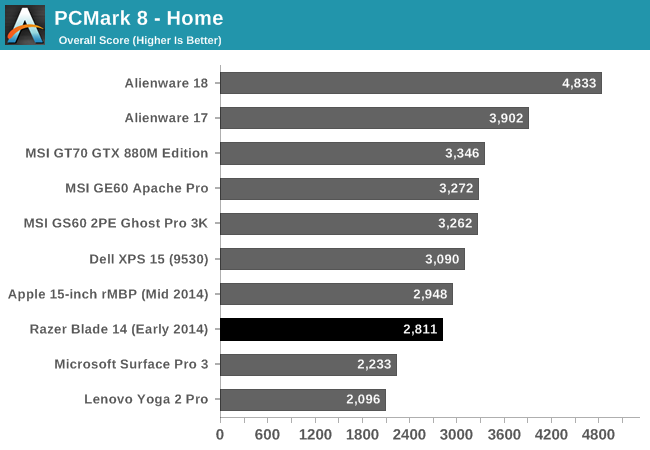
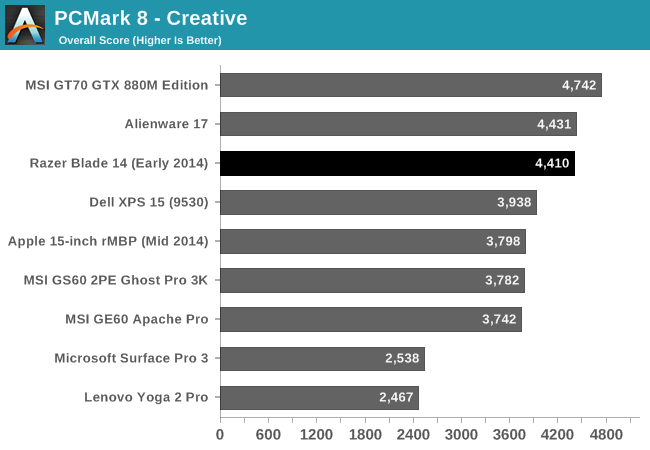

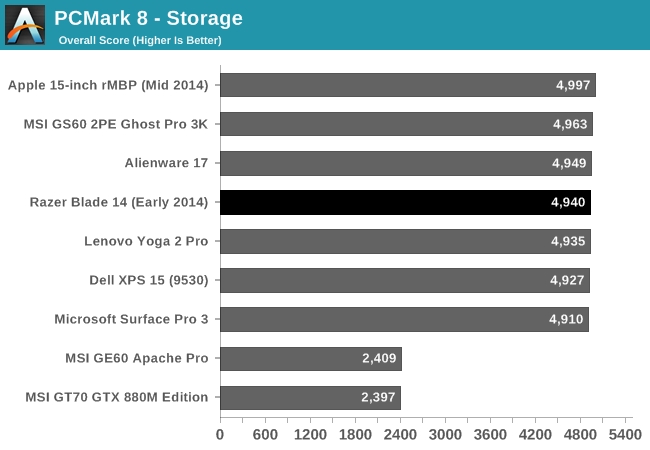
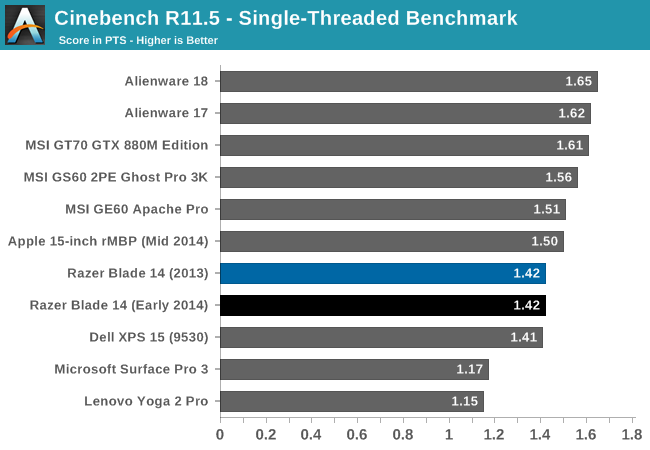
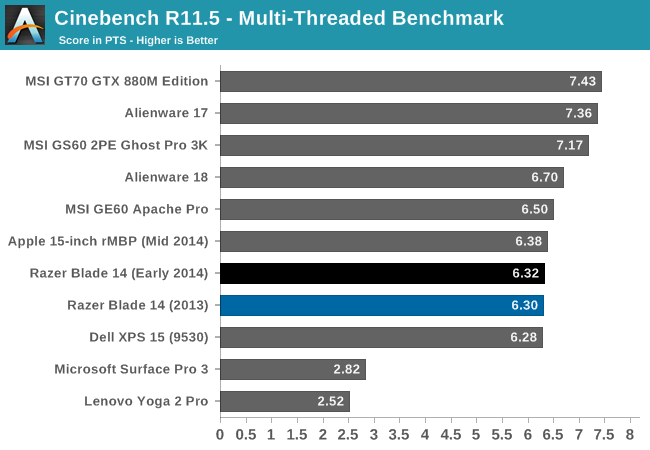
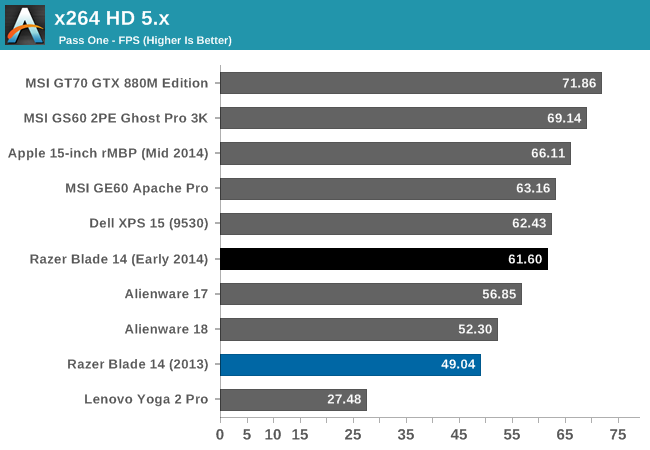
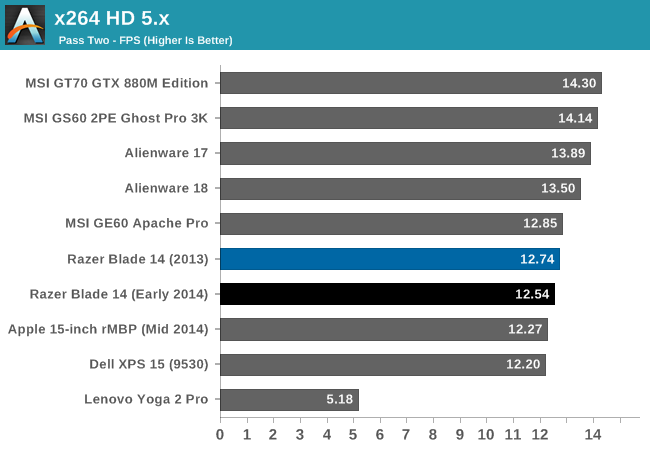
With the 37 watt CPU, the Razer Blade falls right where you would expect. Overall, there is more performance than the Ultrabook class machines such as the Yoga 2 Pro and the Surface Pro 3, but other gaming laptops with higher wattage CPUs are a bit faster. Still, for the Razer Blade’s intended use scenario, system performance is great. The M.2 SSD in the Razer Blade performs very well in the PCMark 8 Storage test, scoring very close to the rest of the SSD pack.
WiFi
The new Razer Blade has updated the WiFi card from the previous version that used a Killer Wireless-N 1202 dual-band 2x2 802.11a/b/g/n solution. The new Blade now features the Intel Dual-Band Wireless-AC 7260, which adds support for 802.11ac. This wireless card is a 2x2:2 card offering connection speeds up to 866 Mbps on an 802.11ac connection.
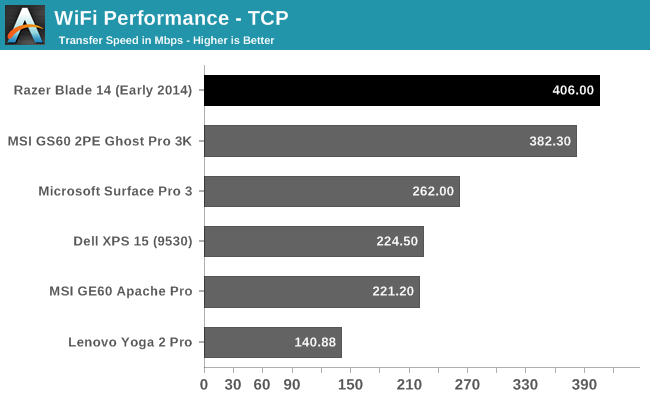
With around 400 Mbps sustained transfer speeds, the Intel wireless card does pretty well with the router close by, but in other tests Ganesh has found that the Broadcom BCM4352 card performs better, especially with some drywall between you and the router. With the Razer Blade 30’ from the router in another room, the wireless speeds dropped to around 270 Mbps, which is still a reasonable result. Still, the Blade has 802.11ac and therefore supports both 5 GHz and 2.4 GHz, so there is not too much to complain about here. The Intel card also performs the Bluetooth 4.0 functions.










69 Comments
View All Comments
Notmyusualid - Saturday, October 11, 2014 - link
I am a VERY frequent traveller, and I've seen a few Alienware backpacks as I go through airports.I carry my M18x R2 with me everywhere I go, and yes it is heavy, but they are made for adults, right?
Every customer I meet is fascinated to meet my Alienware machine, and it is a great talking point when meeting new customers.
And what is with your 2hrs of battery life? Are you not aware we have integrated graphics, on a 96whr 12-cell battery? Imagine how long that lasts...
If you think there is an image problem associated with these machines, I'd quite enjoy you expressing that opinion to my face... whilst demonstraiting what machine you carry around.
Connoisseur - Saturday, October 11, 2014 - link
I thought it's fairly obvious I carry around a Razer Blade 2014. Listen, I'm not here to get into a laptop beat down contest and I'm a little confused as to why you want me to say anything to your face. I'm not insulting your family, merely your commentary on why people shouldn't be buying these machines. The markets for the two types of machine are very different. Alienware is marketed to and has the reputation of being a college gamers machine; it's always been this way. Their design language and form factor scream "Look at me! I'm sparkly and huge and look like a sci-fi tank!" I used to build systems like that back in college which had LED's with cases that had crazy angles. As I aged, my tastes changed and I preferred something that looks more subtle and slimmer. My wife would make endless fun of me if I carried that monster around.If you're comfortable toting around 15lbs total of computer parts (laptop + power brick) and using an 18" screen on an airplane tray or on your lap, more power to you. I prefer something I can tuck under my arm. Not to mention that I frequently have to also carry around my work laptop and the use case for a slim, lightweight gaming system makes a lot of sense.
DPOverLord - Friday, October 10, 2014 - link
Doesn't seem that great. Did they need such a high res screen? For $2k that GPU may not run it well. Make it a 970/980 with the new refresh.Then upgrade the CPU... Also, weight should not go up.
DPOverLord - Saturday, October 11, 2014 - link
Realized this is not new. Stop reviewing 'old hardware' or at least put a spoiler that you're reviewing something that came out months ago. Bit confusing since I was here thinking "wtf is razer doing"zepi - Friday, October 10, 2014 - link
It sure looks nicer than MSI GS60, but is that alone worth the extra cost? Especially when new version of the MSI is just about to come out with GTX 970M...whyso - Friday, October 10, 2014 - link
Love the review but I feel that these notebook reviews need for the games and CPU benchmark sections the CPU and GPU name beside the name of the notebook for quick and easy comparison.Awful - Friday, October 10, 2014 - link
What use case are they actually targeting with that screen resolution? It sure isn't gaming...Morawka - Friday, October 10, 2014 - link
i wonder how a gaming laptop would be if it used Broadwell Core M for very low power dual core performance at 5-10 watt, and devote the rest of the TDP to GPU. This would prevent throttling whene on battery so long as total system draw is under 100W. 100W is about the peak of what laptop batteries can put out.kallogan - Saturday, October 11, 2014 - link
i'd like to see that too a core m 5yxx would run easy at constant full dual core turbo in a notebook chassis even with a very weak cooling, would give enough cpu power and would let the gpu a lot of tdp room !!!! Under 100W with a premium class gpu would be great.But sadly i don't think core m 5yxx are intended to be paired with discrete gpus, only for convertibles tablets and such but we'll see. Later Broadwell cpus it will be.
But as a gamer concerned mostly by cooling and noise and not caring for a premium cpu as long as there is no major cpu limiting i'm definitely for devoting the power to gpus !!!
limitedaccess - Saturday, October 11, 2014 - link
ULV and lower power Intel mobile CPUs (including the new Core-M series) are limited to PCie 2.0 x4 while M/Q CPUs have the a full PCie 3.0 x16 available to them.The only GTX x60m+ class laptop I'm aware of that pairs with a non M/Q CPU was the announced (but not yet released) Alienware 13 with a Haswell-U + GTX 860m. However there was, I believe, some uncertainty regarding whether that will be the actual CPU configuration.